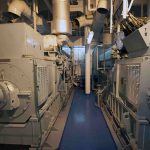Diesel and gasoline engines function similarly in that they both use atomized fuel and internal combustion to produce power.
The difference lies in the phases of the power explosion. A gasoline engine injects an air-fuel mixture into the cylinders, then is ignited for combustion. A diesel engine first must compress the air, then the fuel is injected. The compression heats up the air to increase the efficiency of ignition. There are three main phases of diesel engine combustion.
First Phase of Combustion – Ignition delay period
Ignition delay period is the time span between commencement of injection and the start of ignition.
· The fuel emerges into the cylinder as small liquid particles, which are surrounded by hot compressed air.
· They receive heat from the air and more volatile constituents of the fuel vaporise.
· During the ignition delay period a large part of the fuel charge is prepared for combustion.
· During the ignition delay, the injector continued to inject the fuel and, if this has built up a sufficient quantity, the rapid combustion and pressure rise will be quite violent, causing detonation and shock loading creating a noise termed diesel knock.
Second Phase of Combustion – Flame spread
Rapid or uncontrolled combustion usually occur just after the ignition of the fuel vapours.
· After ignition commences flame propagation proceeds very quickly in the fuel vapour or air mixture, accompanied by rapid temperature and pressure rise.
· Towards the end of the rapid pressure rise a point is reached where the rate of pressure rise falls away quickly, and the curve flattens out towards the maximum pressure point.
· The point where the rate of pressure rise changes near and approaching the maximum pressure point is the end of the second phase of combustion.
Combustion Process
 Combustion Process
Combustion Process
1. Start of Injection
2. Beginning of Ignition
3. Maximum Pressure
4. End of Injection
5. End of Ignition
6. End of After Burning
1 – 2 : Ignition – Delay Period
2 – 3 : Rapid / Uncontrolled Combustion
2 – 4 : Ignition Period
3 – 4 : Controlled Combustion
5 – 6 : After Burning
Third Phase of Combustion – Direct burning
Controlled combustion is regulated by the rate at which fuel continues to be delivered.
· This shows only a small pressure rise, as the rate is decreased due to downward movement of the piston.
· The end of injection occurs approximately at or slightly beyond the maximum pressure point.
After Burning
After burning is said to occur when the third phase of combustion extends over a long period.
It may be caused by incorrect fuel grade, bad atomization, poor or excess penetration, incorrect fuel temperature, incorrect injection timing, insufficient air supply, or any combination of these.
Slow burning, high viscosity, high density, high carbon content fuels may also cause after burning of a serious nature leading to engine damage.
Effect of After Burning
After burning creates high exhaust temperatures and may cause overheating of the engine in severe cases. Some drop in the maximum firing pressure usually accompanies this. There is a loss of thermal efficiency when after burning occurs, due to greater loss of heat to exhaust gases and the transfer of large amount of heat to the cooling water. There is a risk of damage to exhaust valves and scavenge fires.


